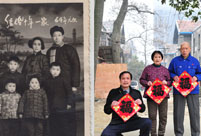SEOUL, Feb. 24 -- Combined forces of South Korea and the United States on Monday began their annual military exercises, which came amid thawing signs of inter-Korean relations.
The"Key Resolve"command post exercise will run from Feb. 24 to March 6, and the "Foal Eagle"field training exercise will continue through April 18, according to Seoul's Defense Ministry.
Around 5,200 U.S. troops, including 1,100 arriving from off the Korean Peninsula, will participate in the computer-simulated"Key Resolve." Some 7,500 American forces, including 5,100 from overseas, will join the "Foal Eagle."
The number of U.S. servicemen taking part in the Key Resolve was up from 3,500 last year, but the figure for the Foal Eagle was down from around 10,000 in 2013.
The mixed figure was attributable to the U.S.'s automatic spending cuts, which caused a reduction in the budget-spending field training exercise and an expansion in the computer-simulated command post exercise.
Around 10,000 South Korean troops will participate in the Key Resolve, and some 200,000 soldiers will take part in the Foal Eagle drills, which involve a set of ground, air, naval, expeditionary and special operations. "South Korea and the U.S. plan to conduct the Key Resolve and Foal Eagle military exercises as scheduled without any change in schedules and scales from today, " Defense Ministry spokesman Kim Min-seok told a routine press briefing.
This year's annual spring war games came amid thawing signs of inter-Korean relations. The two Koreas have held reunion of families separated by the 1950-53 Korean War, the first in more than three years, from last Saturday in the Democratic People's Republic of Korea (DPRK)'s Mount Kumgang resort.
The second round of the family reunion began Sunday, which will run through Tuesday. A group of 357 elderly South Koreans crossed the inter-Korean border by bus to the reunion venue to meet their long-lost relatives from the DPRK.
On Saturday, 80 elderly South Koreans, accompanied by 56 family members, came back from the mountain resort after spending three days with their DPRK relatives during the first round of reunions.
The 19th round of reunion, the first such humanitarian event since November 2010, came after top DPRK leader Kim Jong Un voiced his willingness to improve relations with South Korea in his New Year's speech.
During last year's joint exercises, the U.S. Air Force flew nuclear-capable B-52 bombers over the Korean Peninsula as well as B-2 stealth bombers, which conducted its first-ever firing drill on the peninsula.
Tensions escalated on the peninsula as the DPRK staged its third nuclear test last February, just two months after launching the three-stage, long-range rocket called Unha-3, which South Korea claimed was a long-range missile to carry nuclear warhead.
South Korea has asked the U.S. to delay the transfer of wartime operational control of allied forces, citing growing DPRK threats to the point where Pyongyang threatened a nuclear strike against South Korea and the U.S. territory.
The wartime command of combined forces was initially supposed to be transferred to South Korea in 2007, but was postponed twice to December 2015. It was widely expected to be delayed once more later this year.
Last year's Key Resolve exercise was first commanded by the South Korean Joint Chiefs of Staff to brace for the wartime control transfer, but this year's exercises will be led again by the top U.S. Forces Korea commander.
The Defense Ministry said in its annual policy report to President Park Geun-hye that it will apply a new"tailored deterrence"strategy to this year's joint war games with the U.S. to enhance deterrence capabilities against DPRK's possible nuclear threats.
In October 2013, South Korean Defense Minister Kim Kwan-jin and his U.S. counterpart Chuck Hagel signed a new"tailored deterrence" strategy, which outlined deterrence against three possible scenarios of nuclear threats from the DPRK.
The scenarios include threatening, impending usage and usage of nuclear weapons, allowing preemptive strikes to be carried out against nuclear threats.
 Most gorgeous female celebs in Chi-pao
Most gorgeous female celebs in Chi-pao Second round of test kicks off at Beijing Film Academy
Second round of test kicks off at Beijing Film Academy Ancient Qiang people had vertically grown teeth
Ancient Qiang people had vertically grown teeth Top 10 Chinese youth’s favorite seaside destinations
Top 10 Chinese youth’s favorite seaside destinations Traditional Tibetan clothing tailors
Traditional Tibetan clothing tailors In photos: Unveiling Taishan station
In photos: Unveiling Taishan station Beautiful moments of family reunion
Beautiful moments of family reunion 10 Valentine's Day ideas for couples
10 Valentine's Day ideas for couples Let's get married today!
Let's get married today! Chinese warplanes C919 to appear at Singapore Airshow 2014
Chinese warplanes C919 to appear at Singapore Airshow 2014 Ruins of Shang Dynasty's structure unearthed in Shaanxi
Ruins of Shang Dynasty's structure unearthed in Shaanxi  Intercity high speed train in operation
Intercity high speed train in operation Severe coldness freezes large parts of China
Severe coldness freezes large parts of China  Beautiful moments of Sochi
Beautiful moments of Sochi  It's not just performing this year
It's not just performing this yearDay|Week|Month